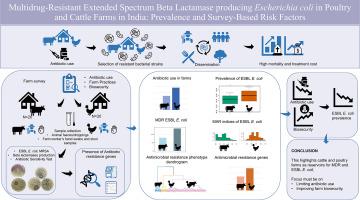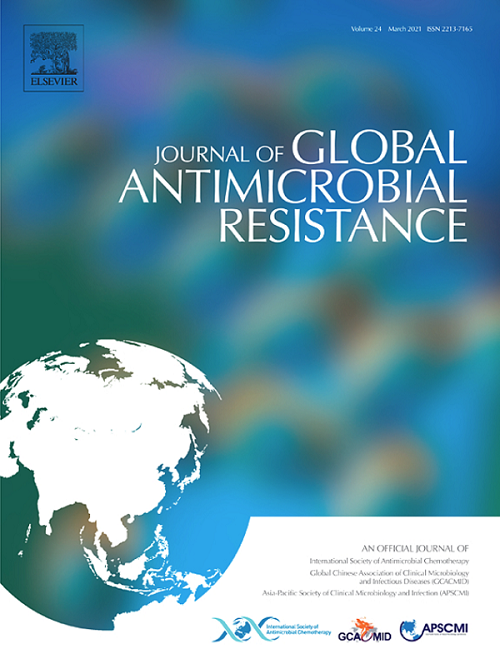印度家禽和牛场产生多药耐药扩展谱β -内酰胺酶的大肠杆菌:患病率和基于调查的风险因素。
IF 3.2
3区 医学
Q2 INFECTIOUS DISEASES
引用次数: 0
摘要
目的:在动物生产中不受管制地使用抗生素导致多种耐药细菌的出现,包括产生广谱β -内酰胺酶的大肠杆菌(ESBL E. coli),对公共卫生构成重大威胁。本研究旨在利用同一健康框架中的人-动物界面方法,评估和比较牛和家禽以及农场工人在ESBL大肠杆菌出现和传播中的作用。方法:对印度卢迪亚纳市20个养牛场和20个家禽养殖场进行调查,了解养殖场抗生素使用情况和生物安全性。检查了动物粪便/家禽粪便、农场工人的手拭子和粪便样本是否存在ESBL大肠杆菌。筛选菌株的药敏和耐药基因(ARGs)。广义线性混合模型(GLMM)探讨了基于农场动物种类、实践和生物安全措施的ESBL大肠杆菌流行率的变化。结果:与牛(46%)和农场工人(12%)相比,家禽(63.5%)中ESBL大肠杆菌的患病率更高,这与家禽(85%)比牛(70%)使用更高的抗生素相一致。大多数分离株(86.52%)具有多重耐药(MDR),其中家禽场分离株97%耐药,90.7%携带blaCTXM基因。GLMM分析显示,生物安全性的提高和抗生素使用的减少与ESBL大肠杆菌感染率的降低有关。结论:本研究强调牛和家禽养殖场是耐多药耐药和ESBL大肠杆菌的宿主,导致ARGs的环境负担增加。它强调有必要减少动物养殖,特别是家禽养殖中抗生素的使用,以应对新出现的抗生素耐药性,保护动物和人类健康。本文章由计算机程序翻译,如有差异,请以英文原文为准。

Multidrug-resistant extended-spectrum beta-lactamase-producing Escherichia coli in poultry and cattle farms in India: Prevalence and survey-based risk factors
Objective
Unregulated use of antibiotics in animal-production leads to the emergence of multidrug-resistant (MDR) bacteria, including extended-spectrum beta-lactamase-producing Escherichia coli (ESBL E. coli), posing significant public health threats. This study aimed to assess and compare the role of cattle and poultry, along with farmworkers, in the emergence and spread of ESBL E. coli using a human-animal interface approach in One-Health framework.
Methods
Twenty cattle and 20 poultry farms in Ludhiana, India, were surveyed to determine antibiotic usage and biosecurity in farms. Animal faeces/poultry droppings, farmworkers hand swabs, and stool samples were examined for the presence of ESBL E. coli. The isolates were screened for antibiotic susceptibility and antimicrobial resistance genes. Generalized linear mixed models explored the variations in ESBL E. coli prevalence based on farm animal species, practices, and biosecurity measures.
Results
A higher prevalence of ESBL E. coli was identified in poultry (63.5%) compared to cattle (46%) and farmworkers (12%), which aligns with higher antibiotic use in poultry (85%) than cattle (70%). Most isolates (86.52%) were MDR, with poultry farm isolates having 97% MDR and 90.7% carrying the blaCTXM gene. Generalized linear mixed models analysis revealed improved biosecurity and low antibiotic use were associated with lower ESBL E. coli prevalence.
Conclusions
This study highlights cattle and poultry farms as reservoirs for MDR and ESBL E. coli, contributing to rising environmental burden of antimicrobial resistance genes. It underscores the need to reduce antibiotic use in animal farming, particularly poultry, to address emerging antibiotic resistance and protect both animal and human health.
求助全文
通过发布文献求助,成功后即可免费获取论文全文。
去求助
来源期刊

Journal of global antimicrobial resistance
INFECTIOUS DISEASES-PHARMACOLOGY & PHARMACY
CiteScore
8.70
自引率
2.20%
发文量
285
审稿时长
34 weeks
期刊介绍:
The Journal of Global Antimicrobial Resistance (JGAR) is a quarterly online journal run by an international Editorial Board that focuses on the global spread of antibiotic-resistant microbes.
JGAR is a dedicated journal for all professionals working in research, health care, the environment and animal infection control, aiming to track the resistance threat worldwide and provides a single voice devoted to antimicrobial resistance (AMR).
Featuring peer-reviewed and up to date research articles, reviews, short notes and hot topics JGAR covers the key topics related to antibacterial, antiviral, antifungal and antiparasitic resistance.
 求助内容:
求助内容: 应助结果提醒方式:
应助结果提醒方式:


